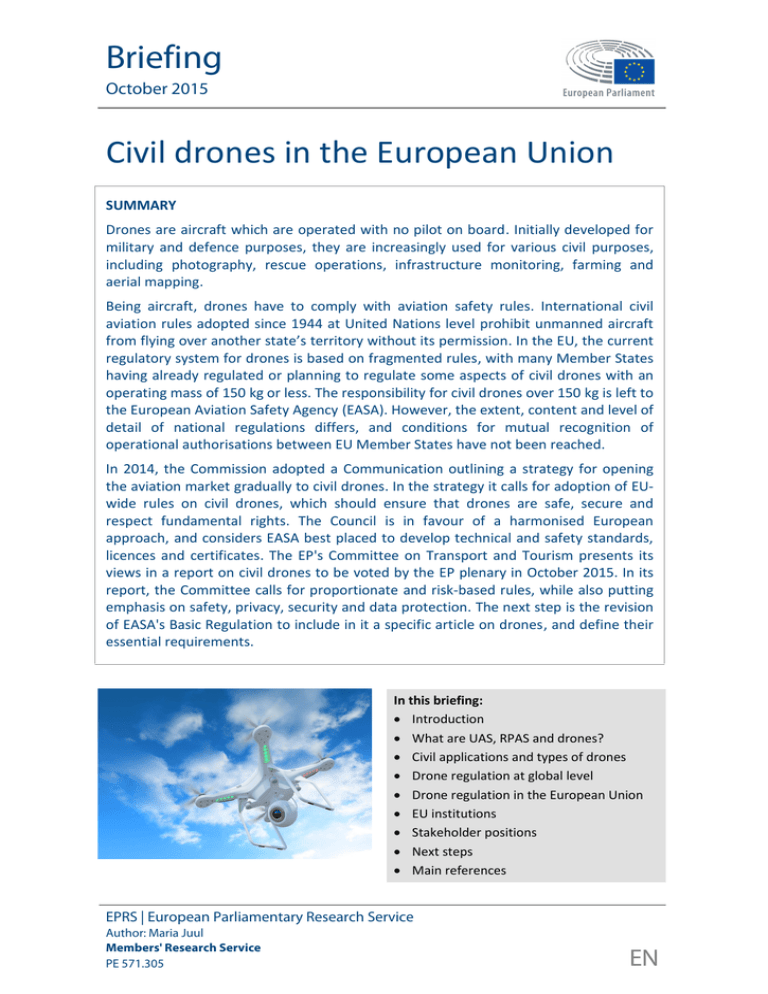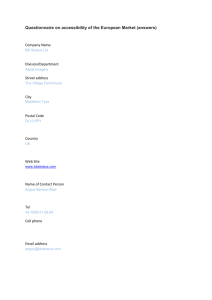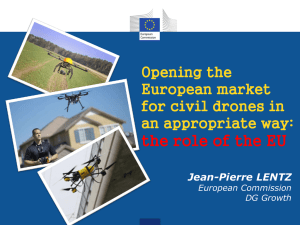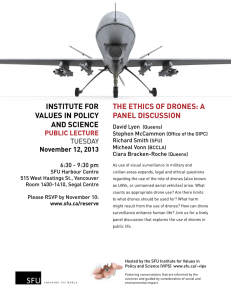Civil drones in the European Union
advertisement

Briefing October 2015 Civil drones in the European Union SUMMARY Drones are aircraft which are operated with no pilot on board. Initially developed for military and defence purposes, they are increasingly used for various civil purposes, including photography, rescue operations, infrastructure monitoring, farming and aerial mapping. Being aircraft, drones have to comply with aviation safety rules. International civil aviation rules adopted since 1944 at United Nations level prohibit unmanned aircraft from flying over another state’s territory without its permission. In the EU, the current regulatory system for drones is based on fragmented rules, with many Member States having already regulated or planning to regulate some aspects of civil drones with an operating mass of 150 kg or less. The responsibility for civil drones over 150 kg is left to the European Aviation Safety Agency (EASA). However, the extent, content and level of detail of national regulations differs, and conditions for mutual recognition of operational authorisations between EU Member States have not been reached. In 2014, the Commission adopted a Communication outlining a strategy for opening the aviation market gradually to civil drones. In the strategy it calls for adoption of EUwide rules on civil drones, which should ensure that drones are safe, secure and respect fundamental rights. The Council is in favour of a harmonised European approach, and considers EASA best placed to develop technical and safety standards, licences and certificates. The EP's Committee on Transport and Tourism presents its views in a report on civil drones to be voted by the EP plenary in October 2015. In its report, the Committee calls for proportionate and risk-based rules, while also putting emphasis on safety, privacy, security and data protection. The next step is the revision of EASA's Basic Regulation to include in it a specific article on drones, and define their essential requirements. In this briefing: Introduction What are UAS, RPAS and drones? Civil applications and types of drones Drone regulation at global level Drone regulation in the European Union EU institutions Stakeholder positions Next steps Main references EPRS | European Parliamentary Research Service Author: Maria Juul Members' Research Service PE 571.305 EN EPRS Civil drones in the European Union Glossary Air traffic management: consists primarily of air traffic control (ensuring that aircraft are safely separated in the sky and at airports), air traffic flow management (sending flight plans to a central repository, analysing and computing them) and aeronautical information services (compilation and distribution of aeronautical information needed by airspace users, e.g. on safety). Command and control link: data link between the drone and the remote pilot station, which manages the flight. 'Detect and avoid' technology: capability of the drone to remain at safe distance from, and to avoid collisions with other aircraft. Geo-fencing: software using GPS signals to stop drones flying into certain areas. Remote pilot: person who is in control of the flight path of the aircraft. Segregated airspace: airspace of specified dimensions assigned for exclusive use to specific users. Sources: 'Unmanned Aircraft Systems', United Nations, 2011; Eurocontrol, European RPAS Steering Group roadmap, 2013. Introduction The first automatic aircraft flights took place about a hundred years ago. Since then many other attempts have been made to remotely control and land pilotless aircraft. Drones were initially developed for military and defence purposes. Recently, technical developments (e.g. in lightweight materials and on-board computers) have made drones increasingly popular for civil uses also. Thousands of enterprises, mostly SMEs,1 in the EU develop, manufacture and use drones in infrastructure monitoring, aerial mapping and many other industries. Mass production and miniature electronics have made drones small and cheap enough now to be accessible to individuals. The potential scale of the drone market is difficult to predict with precision. It has been estimated that in the next 10 years it could be worth 10 % of the EU aviation market (i.e. about €15 billion per year). By 2050, the drone industry could, according to the European Commission, create some 150 000 jobs in the EU, spread across manufacturers, operators and other actors providing drone-enabling technologies (such as flight control, sensors and energy). As with any technology, drones pose various risks. In some cases drones have narrowly missed commercial manned aircraft, flown over or landed on the residences of public figures, nuclear power stations, embassies and tourist attractions, obstructed firefighting and injured people. People are also concerned about their privacy. Drones usually carry video cameras to allow the remote pilot to fly them. These may record images and include technologies such as high-power zoom, microphones and a multitude of sensors as well as GPS systems recording the location of persons filmed. They can for instance fly over closed gardens, follow individuals on the streets and count how many people there are in a particular building or room. All this can make drones highly intrusive. Being aircraft, drones have to comply with aviation safety rules. International rules adopted at UN level forbid unmanned aircraft to fly unless the national competent authorities issue a specific individual authorisation. Hence the current regulatory system Members' Research Service Page 2 of 8 EPRS Civil drones in the European Union for drones in the EU is based on fragmented rules leading to ad hoc operational authorisations. As the national authorisations do not benefit from mutual recognition and do not allow for EU-wide activities, a single market for drone services in the EU can only be achieved if drones are integrated into the European aviation system. Other countries outside the EU are also preparing rules on drones. For instance, in February 2015, the US Federal Aviation Administration presented draft rules on small drones (under 25 kg) conducting non-leisure and non-governmental operations.2 These rules would limit flights to daylight and to the operator's visual line of sight, and address inter alia height and operational restrictions, operator certification and aircraft registration. Flights over people3 and in airport flight paths would be forbidden. What are UAS, RPAS and drones? The term 'drone' signifies an unmanned aircraft system (UAS). This is an 'aircraft and its associated elements which are operated with no pilot on board'.4 Two types of UAS can be differentiated: 1. Remotely piloted aircraft systems (RPAS): systems comprising an aircraft that the pilot controls from a distant pilot station (e.g. on the ground or inside a building), one or more associated remote pilot stations, command and control links and any other components necessary for operations (e.g. take-off ramp). 2. Autonomous UAS: unmanned aircraft systems which function autonomously and are controlled by a computer without pilot intervention after take-off. Often the terms UAS, RPAS and 'drone' are used as synonyms. Whether they designate all types of drones (including autonomous UAS) or only those that the pilot remotely controls, is not always clear. However, in the context of regulation, autonomous UAS are excluded as they are currently not authorised for use, and public authorities (including the EU) do not currently seek to regulate them. Civil applications and types of drones Drones vary greatly in size, performance and type. They can be as small as an insect (almost invisible or inaudible) or as big as manned aircraft. They can hover or reach a speed of more than 1 000 km/h, be controlled e.g. via smart phone, tablet software or satellite communication, launched e.g. through a rocket, catapult or by hand and carry all kinds of materials (e.g. cameras or fertilisers). Although advanced technologies also allow drones to fly at high altitude for a long time and cover considerable distances, most of them today fly at less than 150 m above ground. At this height, the airspace is mostly used by gliders and micro lights (1 or 2-seater aircraft). Drone technology has become available, or might in the future, for many kinds of uses, regulated at different levels (see table 1). Drones can reduce human exposure to long, monotonous, dirty or dangerous tasks as well as provide potential economic savings and environmental benefits (reduced fuel consumption, fewer CO2 emissions). Drones, which can fly closer to the ground than manned aircraft, are considered wellsuited for risky flights to accident areas. They can help in fire-fighting; overfly flooded areas or areas affected by a chemical or biological attack and find missing persons. Drones can also help authorities, for instance, in border control, and they have various uses in science (e.g. in earth observation). In addition, they can deliver commercial services such as infrastructure (e.g. bridges, railways, nuclear plants) maintenance and monitoring, aerial mapping, filming, farming (e.g. fertilisation of plants), forestry Members' Research Service Page 3 of 8 Civil drones in the European Union EPRS (e.g. planting trees) and fisheries. They may deliver packages, complete coverage of telecommunications, tackle gas or chemical leaks or carry cargo. Private users are also using drones for various legal and illegal purposes, ranging from photography to drug trafficking. Table 1 - Different types of drones on the basis of weight Type of drone Small (<20/25 kg) Price: €14028 000 Light (20/25-150 kg) Price: €55 000420 000 Large (>150 kg) Price: €670 000 and above Current and potential future uses Current regulation Leisure and commercial use (e.g. surveillance, inspection, photography) Falls under Member State regulations Used in geospatial surveying and wide-area surveillance. Potential to inspect pipelines and power cables, spray crops, search and rescue, control borders and monitor forest fires Falls under Member State regulations Used by the military and defence forces. Potential to carry cargo and passengers Civil drones with an operating mass of more than 150 kg fall under Regulation 216/2008/EC and EASA competency, unless operated by a state agency Data source: European Parliament study on 'Privacy and Data Protection implications of the civil use of drones', 2015, p. 12. Drone regulation at global level Global rules covering unmanned aircraft are established at United Nations level by the Convention on International Civil Aviation (the Chicago Convention) which was signed in 1944 and already at that time set some basic rules on unmanned aircraft. Article 8 of the Chicago Convention prohibits all unmanned aircraft from flying over another state’s territory without its permission. It also obliges states to ensure that flights without a pilot in regions open to civil aircraft are controlled so as to eliminate danger to civil aircrafts. The annexes of the Convention are also relevant as they include international standards and practices e.g. on pilots' licences, operations and airworthiness of aircraft. The administration and governance of the Chicago Convention is managed by the International Civil Aviation Organization (ICAO). ICAO adopts Standards and Recommended Practices (SARPs)5 applicable to international civil aviation, including to RPAS, and publishes various guidance materials to assist states in developing national aviation regulations. In 2007, ICAO set up an RPAS study group (later elevated to the status of a panel), which in 2011 clarified the general principle underpinning routine operations of drones, and specified that since drones are aircraft, the major parts of the regulatory framework applicable to manned aircraft are directly applicable to them too. It also drafted several amendments to some Annexes of the Chicago Convention, ruling inter alia that drones need to be certified for their safety, be under the command of a licenced remote pilot and be under the responsibility of a certified drone operator. Besides ICAO, several states are working together within Joint Authorities for Rulemaking on Unmanned Systems (JARUS), currently chaired by EASA, to develop Members' Research Service Page 4 of 8 EPRS Civil drones in the European Union recommendations for a single set of technical, safety and operational requirements on drones (e.g. on pilots' licences or processes for airworthiness). Drone regulation in the European Union Currently, EASA has the mandate (under Regulation 216/2008/EC) to regulate RPAS when used in civil applications and with an operating mass of more than 150 kg. EU Member States and the national civil EASA and RPAS aviation authorities regulate experimental In 2014, the Commission asked EASA to develop a or amateur-build RPAS, military and nonnew regulatory framework for RPAS operations military governmental RPAS flights, civil and proposals for rules on low-risk RPAS RPAS with an operating mass of 150 kg or operations by the end of 2015. Both aspects were less, as well as model aircraft.6 included in a document that EASA published in Many countries (e.g. France, Germany, Italy, UK, Austria and Denmark) have adopted, or are about to adopt (e.g. Belgium), rules on some aspects of civil RPAS with an operating mass of 150 kg or less. However, the extent, content and level of detail of the rules differ, and conditions for mutual recognition between EU countries have not been reached. This impacts cross-border operations directly as RPAS operators have to apply for a separate authorisation in each country. July 2015, giving stakeholders the possibility to comment up to 25 September 2015. It proposes to regulate all RPAS at EU level and to adopt different rules based on their operations and risks (not based on mass). 'Open' category (low risk): minimal rules, defining limits for operations, to be overseen by the police. Authorisation from a National Aviation Authority (NAA) would not be required, even for commercial operations. 'Specific operation' category (medium risk): would need authorisation from a NAA. Each risk would be analysed and mitigated via a safety risk assessment. Member States' approaches follow some common principles, such as categorisation 'Certified' category (higher risk): rules similar to manned aircraft (e.g. pilot's licence and based on mass as well as operational and certification required). altitude limits, but concrete rules vary. While many countries allow RPAS with an EASA has also proposed to add a specific article to operating mass of 150 kg or less to fly only its Basic Regulation, and define complementary in visual line of sight, some, like Spain, essential requirements. accept going beyond that limit with a special permit. Some impose a limit for distance from the pilot (around 500 m) and nearly all require RPAS to being operated at safe distance from other vehicles, buildings or individuals. Most countries require insurance and accident reporting. For RPAS above 20-25 kg, most Member States require that the operator is approved by the competent national authority, the pilot has a licence and the RPAS undergoes a technical evaluation. EU institutions European Commission The Commission has supported the development of RPAS since the end of the 1990s; in the early days mostly through investment in RPAS research and innovation. It is now focused on preparation of an EU regulatory framework aimed at ensuring a true European single market for aerial services. In 2012, after having completed a set of consultations, the Commission published a staff working document on the civil use of RPAS, and established a European RPAS steering group to plan and coordinate EU work on civil RPAS. In 2013, the steering group Members' Research Service Page 5 of 8 EPRS Civil drones in the European Union presented its recommendations in a roadmap which covers all type of RPAS, except model aircraft and toys. The roadmap identified potential improvements to the existing regulatory framework and outlined the research and technologies necessary for the safe integration of RPAS into the EU aviation system. Subsequently, in 2014, the Commission adopted a Communication outlining a strategy for opening the aviation market to the civil use of RPAS in a safe and sustainable manner. It focuses upon how to enable the development of RPAS while at the same time addressing their societal impact. The Commission noted its intention to take a step-by-step approach, by firstly regulating drone operations with mature technologies. More complex operations would be permitted progressively. In the longer term, the objective is to integrate RPAS in non-segregated airspace which is open to all civil air transport. The strategy highlights that the rules should ensure that RPAS are safe and secure. Rules should be as international as possible and proportionate to the risk associated with operating each RPAS. The current restricted scope of competence of EASA (limited to RPAS with an operating mass over 150 kg) should be reviewed. The division between RPAS below and above 150 kg is, according to the Commission, an 'arbitrary cut off point'7 as the risk of RPAS operations does not necessarily depend on the mass of the RPAS used. Rules should ensure respect for fundamental rights such as the right to private and family life and the protection of personal data. RPAS also require provisions that those liable for accidents can be identified and are able to meet their financial obligations. Additionally, the Commission will use the possibility to give SMEs and start-ups in the sector financial support from EU instruments such as the Horizon 20208 and COSME programmes.9 It will also identify in its own policies and programmes (such as the EU's Earth Observation Programme, Copernicus) opportunities to promote the use of RPAS. Riga Declaration The European aviation community agreed at a conference in Riga on 5-6 March 2015 on the following principles to guide the drone (RPAS) regulatory framework in Europe: 1. Drones should be treated as new types of aircraft and regulated proportionally to the risk of each operation. 2. Safety rules for drones should be developed urgently at the EU level. 3. Public authorities and the industry should invest in the technologies and standards that are needed to integrate drones into the EU aviation system. 4. Public acceptance of drone services is of key importance. Privacy and the protection of personal data should be guaranteed. 5. The drone operator is responsible for its use. It should be possible to identify him or her (e.g. via ID chip). Council of the European Union The transport, telecommunications and energy Council held a policy debate in October 2014 on the future use of civil RPAS in the European aviation market. Most ministers were in favour of a harmonised European approach to civil RPAS while taking into account national experiences. Many of them thought that EASA was best placed to develop technical and safety standards, licences and certificates. Ministers expressed their agreement with the gradual and progressive integration of civil drones into normal Members' Research Service Page 6 of 8 EPRS Civil drones in the European Union airspace, while stressing the importance of safety and protecting privacy. Many ministers said that current data protection rules were sufficient for protecting privacy. Some also mentioned the need to tackle possible interference in radio frequencies resulting from the widespread use of RPAS. European Parliament On 15 September 2015, Parliament's Transport and Tourism Committee adopted an own-initiative report on safe use of RPAS (rapporteur: Jacqueline Foster, ECR, UK). The report highlights key issues for RPAS legislation. It suggests distinguishing between regulations for commercial and leisure use and calls for a clear, harmonised and proportionate EU and global framework on a risk-assessed basis. Emphasis is placed on safety, privacy (by design and by default), security and data protection. The report suggests that RPAS should be forbidden to fly in some areas, such as airports, power plants, nuclear and chemical plants, and be equipped with 'detect and avoid' technology, an ID chip and a notice that specifies the basic rules applicable for the use of RPAS. The report also supports the Commission idea to review EASA's limited competency. It is due to be the subject of a plenary vote at the end of October 2015. Stakeholder positions Drone manufacturers and operators have expressed concerns about possible overregulation, especially those operating in Member States with less restrictive rules (e.g. Denmark). At the same time, many of them deplore the absence of harmonised rules at EU level. UVS International10 thinks that the lack of regulatory framework for RPAS 'is preventing industry from building pertinent business cases and launching developments required to answer non-military (governmental, research, commercial) needs'. It also deplores insufficient coordination and difficulties in insuring RPAS. The European Cockpit Association11 (ECA) proposes several measures to limit the possibility of collisions taking place between civil RPAS and aircraft (such as height, distance, weight and speed limits). It calls for registration of RPAS, and to impose visibility standards and equip RPAS with geo-fencing technology as well as auto recovery systems to act in the event of loss of control. Lastly, it calls for insurance and accident reporting to be mandatory and for stricter rules to be imposed on commercial operations. The European Data Protection Supervisor calls inter alia for inclusion of a privacy notice with each RPAS sold within the EU. He also recommends using tools such as automatic masking of private areas and people that are accidentally photographed or filmed. Furthermore, he advocates emphasis on choosing the right tool for the job, i.e. not choosing RPAS with very high resolution sensors if those are not needed for the purpose. Next steps The Commission has announced that in December 2015 it will adopt an aviation package containing among other items a proposal for revision of EASA's Basic Regulation so that all drones would thereafter be within the competence of EU regulation. EASA proposes to adopt implementing rules on low and medium risk RPAS operations shortly after EASA's Basic Regulation is amended. EASA plans to start work on higher Members' Research Service Page 7 of 8 EPRS Civil drones in the European Union risk RPAS operations in 2016. This category is already within the competency of EASA. However, many technologies necessary for their full integration into segregated airspace are not yet fully mature. The Commission is also considering amending a number of other regulations such as Regulation 785/2004/EC on insurance requirements for air carriers and aircraft operators. Article 7 of the Regulation was established in terms of manned aircraft, where mass (starting from 500 kg) determines the minimum amount of third party insurance. Considering that many RPAS weigh much less than 500 kg, it might be necessary to change this threshold. Besides regulatory work, the Commission is also taking other measures to support the development of enabling technologies and to ensure that information on drones is better disseminated. For instance it launched a call for proposals to create a web portal on RPAS regulations, requirements and procedures in Europe (deadline was February 2015). Main references 'Civilian Use of Drones in the EU', House of Lords, 2015. 'Le statut juridique des drones aéronefs non habités', Lars Hoppe, 2008. Endnotes 1 The Commission estimates that SMEs represent more than 80 % of the enterprises that develop, manufacture and use drones with an operating mass of 150 kg or less. 2 The final decision on these rules is expected in 2016. 3 Except those directly involved with the flight. 4 United Nations circular, 'Unmanned Aircraft Systems', 2011, p. 12. 5 SARPs help 'States in managing aviation safety risks, in coordination with their Service Providers'. 6 Toys that are capable of flying but are not equipped with an internal combustion engine are subject to Directive 2009/48/EC on the safety of toys. 7 Page 5 of the Communication. 8 Horizon 2020 is the EU programme that aims to ensure that Europe produces world-class science and facilitates innovation. For the period 2014-2020, it provides €80 billion of funding. 9 The COSME programme aims to support SMES in four areas: facilitate SMEs access to finance, improve framework conditions for competitive and sustainable EU enterprises, promote entrepreneurship and improve access to markets. Its budget for the period 2014-2020 is €2.3 billion. 10 Non-profit association that represents manufacturers of drones, related subsystems, components and equipment, companies supplying services with or for drones, governmental organisations, research organisations and academia. 11 Representative body of European pilots. Disclaimer and Copyright The content of this document is the sole responsibility of the author and any opinions expressed therein do not necessarily represent the official position of the European Parliament. It is addressed to the Members and staff of the EP for their parliamentary work. Reproduction and translation for noncommercial purposes are authorised, provided the source is acknowledged and the European Parliament is given prior notice and sent a copy. © European Union, 2015. Photo credits: © Oleksandr Delyk / Fotolia. eprs@ep.europa.eu http://www.eprs.ep.parl.union.eu (intranet) http://www.europarl.europa.eu/thinktank (internet) http://epthinktank.eu (blog) Members' Research Service Page 8 of 8




